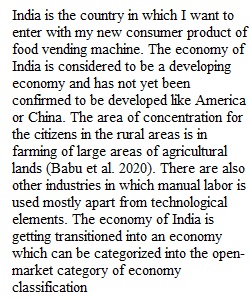


Q MKT 608 Spring 1 ECONOMIC ANALSIS This section generally includes two broad categories: general economic data that serve as a basis to evaluate the economic soundness of the country; and information on business infrastructure, including distribution channels and media. As noted above, the headings in each section are general and intended to provide direction to areas to explore for relevant data. Heading topic area may be emphasize or de-emphasized, depending on the nature of the firm’s product and the country being targeted. • A student will conduct secondary research on the economic environments outlined in “The Country Snapshot”. • The written report should include all of the components noted in the appendix 2 and should be about 5 to 10 single-spaced pages long, 12- font size, 1-inch margin (excluding appendices and references). • Refer to page 616 ~ 618. a. Introduction Include a short economic profile of the country with which you wish to enter. b. Population - Total Population, as well as growth rates, number of live births, and birthrates - Population Distribution (including age, sex, migration rates and patterns, ethnic groups, groups; geographic areas subdivided as urban, suburban, and rural, densities of these) c. Economic Statistics and Activity - Gross national product (GNP or GDP) - Growth Rate - Personal Income Per Capita - Average Family Income - Distribution of Wealth - Income Classes (including lower, middle, upper, and proportion of population in each) d. Primary Indigenous Natural Resources e. Surface Transportation (modes, availability, usage rates) f. Ports (main ports, quality of infrastructure, available services) g. Communication Systems (types, availability, usage rates) h. Working Conditions MKT 608 Spring 2 - Employer-Employee Relationships - Worker Wages and Benefits - White Color Salaries and Benefits i. Labor Force (including size and unemployment rates) j. Principal Industries k. Inward Foreign Direct Investment (including type and amounts of key investment categories) l. International Trade Statistics - Major Exports (including products categories, dollar value per year, and trends) - Major Imports (including products categories, dollar value per year, and trends) - Balance-of-Payments Situation (e.g., surplus or deficit?) - Currency (including recent and historic exchange rates, and forecasts if available) - Trade Barriers (tariffs, non-tariff barriers, quotas, import taxes, and embargoes, if any. Also include here any relevant information on trade barriers and regulations specific to the industry and product) m. Inflation Rates (recent and historic) n. Technology and Science - Level of Technology (computers, machinery, tools, etc. especially as this relates to your industry) - Percentage of GNP Invested in Research and Development - Technological Skills of the Labor Force and General Population (especially, as relevant to the industry) - Channels of Distribution (macro analysis, emphasizing the general level and quality of distribution channels; later you will report on the nature of channels specific to your industry and choose the most appropriate channel as part of your distribution strategy) o. Intermediaries - Retailers (relevant only if your product is primarily a retail good. Include number of retailers, retailers per capita, typical size of retail outlets, and role of chain stores, department stores, and specialty shops) - Wholesale Intermediaries (number and size, usual markup and method of operation, method of payment) - Import and Export Agents - Warehousing (availability, quality, problem areas) MKT 608 Spring 3 - Penetration of Urban and Rural Markets p. Media (macro analysis, emphasizing the general media available in the country; later, you will report on the media specific to your company, and select specific media as part of your recommended marketing strategy). - Availability of Media - Cost of Media (report on the media most relevant to your industry, including television, radio, print, Internet, transit, cinema, outdoor, others) - Advertising Agencies (availability, major ad agencies, typical capabilities) q. References Appendixes for this section (Include here any useful supplementary material such as, for example, helpful tables or charts, reports specific to the industry or market, news articles that are particularly relevant to the company or industry.) REFERENCES Sources of Information for the entire document (REQUIRED) (Don’t forget to track references. Don’t plagiarize! It’s okay to use someone else’s work as long as you cite it and as long as you quote it, if it’s a direct quotation. Put all cited references in the Reference section here.) Source: Adapted from Cateora, Philip, Mary Gilly, and John Graham (2010), International Marketing, 15th ed. New York: Irwin McGraw-Hill HOW TO WRITE A REFERENCES SECTION: EXAMPLES Books: Douglas, S.P. and Craig, C.S. (2008) International Marketing Research, Englewood Cliffs, NJ: Prentice-Hall. World Bank (2012) World Development Indicators, Washington, DC: The World Bank. Articles: Smith, S. (2012) "The New Economy: What It Really Means," Business Week, November 17, pp. 27-31. MKT 608 Spring 4 Knight, G. (1995) "International Marketing Blunders by American Firms in Japan - Some Lessons for Management," Journal of International Marketing, Vol. 3, No. 4, pp. 107-129. Reports: UNCTAD (2013) World Investment Report 2012, New York: United Nations: United Nations Conference on Trade and Development. Internet Sites: Central Intelligence Agency (2001) The World Factbook 2012 (http://www.odci.gov/cia/publications/factbook/index.html), Washington, DC: Central Intelligence Agency. Hoover’s, Inc. (2012) Hoover’s Online (http://www.hoovers.com), Austin, TX: Hoover’s, Inc. Jupiter Communications Inc. (http://www.jup.com), New York, NY.
View Related Questions